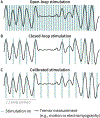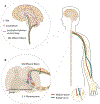Non-invasive electrical stimulation of peripheral nerves for the management of tremor
- PMID: 35220113
- PMCID: PMC9590374
- DOI: 10.1016/j.jns.2022.120195
Non-invasive electrical stimulation of peripheral nerves for the management of tremor
Abstract
Pathological tremor in patients with essential tremor and Parkinsons disease is typically treated using medication or neurosurgical interventions. There is a widely recognized need for new treatments that avoid the side effects of current medications and do not carry the risks of surgical interventions. Building on decades of research and engineering development, non-invasive electrical stimulation of peripheral nerves has emerged as a safe and effective strategy for reducing pathologic tremor in essential tremor. This review surveys the peripheral electrical stimulation (PES) literature and summarizes effectiveness, safety, clinical translatability, and hypothesized tremor-reduction mechanisms of various PES approaches. The review also proposes guidelines for assessing tremor in the context of evaluating new therapies that combine the strengths of clinician assessments, patient evaluations, and novel motion sensing technology. The review concludes with a summary of future directions for PES, including expanding clinical access for patients with Parkinson's disease and leveraging large, at-home datasets to learn more about tremor physiology and treatment effect that will better characterize the state of tremor management and accelerate discovery of new therapies. Growing evidence suggests that non-invasive electrical stimulation of afferent neural pathways provides a viable new option for management of pathological tremor, with one specific PES therapy cleared for prescription and home use, suggesting that PES be considered along with medication and neurosurgical interventions for treatment of tremor. This article is part of the Special Issue "Tremor" edited by Daniel D. Truong, Mark Hallett, and Aasef Shaikh.
Keywords: Afferent pathways; Essential tremor; Neuromodulation; Parkinson's disease; Pathological tremor; Tremor treatment.
Copyright © 2022 Elsevier B.V. All rights reserved.
Conflict of interest statement
Declaration of Competing Interest
APV has no conflicts of interest to disclose. AR is an employee of Cala Health. SD is a scientific advisor of Cala Health. JP has no conflicts of interest to disclose.
Figures




Similar articles
-
Medications used to treat tremors.J Neurol Sci. 2022 Apr 15;435:120194. doi: 10.1016/j.jns.2022.120194. Epub 2022 Feb 19. J Neurol Sci. 2022. PMID: 35279634 Review.
-
Focused ultrasound and other lesioning in the treatment of tremor.J Neurol Sci. 2022 Apr 15;435:120193. doi: 10.1016/j.jns.2022.120193. Epub 2022 Feb 19. J Neurol Sci. 2022. PMID: 35259650 Review.
-
Deep brain stimulation for the treatment of tremor.J Neurol Sci. 2022 Apr 15;435:120190. doi: 10.1016/j.jns.2022.120190. Epub 2022 Mar 4. J Neurol Sci. 2022. PMID: 35299121 Review.
-
The pathophysiology of Parkinson's disease tremor.J Neurol Sci. 2022 Apr 15;435:120196. doi: 10.1016/j.jns.2022.120196. Epub 2022 Feb 19. J Neurol Sci. 2022. PMID: 35240491 Review.
-
Botulinum toxin for the treatment of tremor.J Neurol Sci. 2022 Apr 15;435:120203. doi: 10.1016/j.jns.2022.120203. Epub 2022 Feb 19. J Neurol Sci. 2022. PMID: 35227926 Review.
Cited by
-
Ultrasound Imaging Triggered Tremor Suppression With Personalized Afferent Stimulation Frequency.IEEE Trans Biomed Eng. 2025 May;72(5):1720-1730. doi: 10.1109/TBME.2024.3519628. Epub 2025 Apr 23. IEEE Trans Biomed Eng. 2025. PMID: 40030725
-
Shaking Up Essential Tremor: Peripheral Devices and Mechanical Strategies to Reduce Tremor.Tremor Other Hyperkinet Mov (N Y). 2024 Nov 11;14:55. doi: 10.5334/tohm.930. eCollection 2024. Tremor Other Hyperkinet Mov (N Y). 2024. PMID: 39553441 Free PMC article. Review.
-
Digitising tremor.Lancet. 2023 Jan 21;401(10372):187. doi: 10.1016/S0140-6736(23)00055-7. Lancet. 2023. PMID: 36681408 Free PMC article. No abstract available.
-
Light-Controlled Electric Stimulation with Organic Electrolytic Photocapacitors Achieves Complex Neuronal Network Activation: Semi-Chronic Study in Cortical Cell Culture and Rat Model.Adv Healthc Mater. 2024 Nov;13(29):e2401303. doi: 10.1002/adhm.202401303. Epub 2024 Aug 13. Adv Healthc Mater. 2024. PMID: 39139004 Free PMC article.
-
Classification of Kinematic and Electromyographic Signals Associated with Pathological Tremor Using Machine and Deep Learning.Entropy (Basel). 2023 Jan 5;25(1):114. doi: 10.3390/e25010114. Entropy (Basel). 2023. PMID: 36673255 Free PMC article.
References
Publication types
MeSH terms
Grants and funding
LinkOut - more resources
Full Text Sources
Medical

